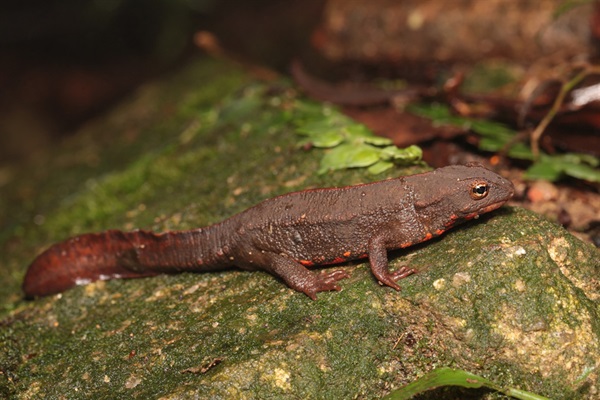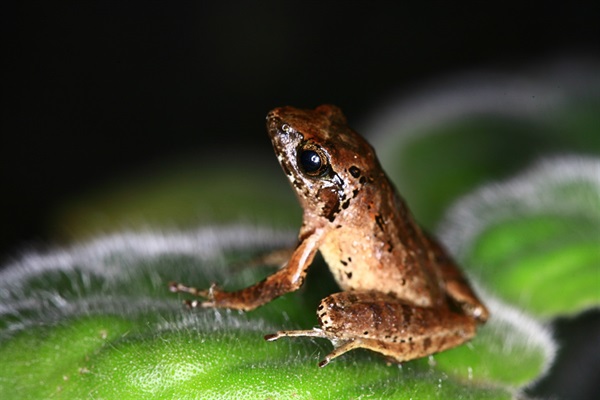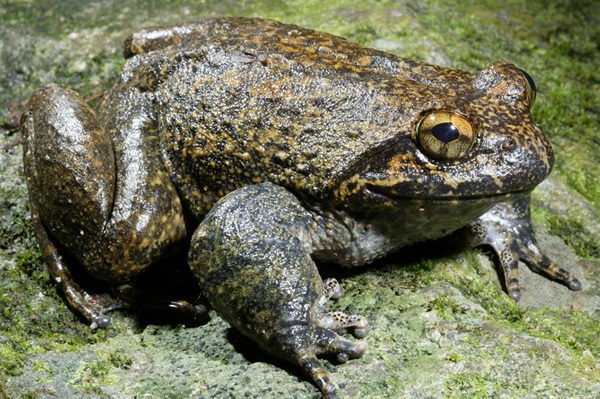Amphibians are animals that spend part of their life in water and part on land. They belong to a group of animals that is composed of creatures with highly varied external morphology and habits, yet they share some common characteristics. Amphibians are cold-blooded; they have bare and usually wet skin, without any scales or hair. Their most special feature is that they have two distinct life phases. Amphibians hatch out as aquatic larvae, breathing through gills; however, as they become mature, they typically develop lungs and legs by a process called metamorphosis, which enables them to leave water and live on land.
Amphibians belong to either Caudata (tailed amphibians) or Anura (tail-less amphibians). Caudates are characterised by an elongated body, a long tail and an apparent neck. They are either aquatic or terrestrial. In Hong Kong, this group is represented by only one species: Hong Kong Newt (Paramesotriton hongkongensis), which can be found in clear mountain streams at all elevations. Anurans consist of frogs and toads. They do not have a defined neck and adults are tail-less. They spend their larval stage (tadpoles) in water, but as adults they are mainly terrestrial. Frogs generally have moist skin, with webbing between their toes. They mostly live near water bodies and are good swimmers. Toads, on the other hand, generally have dry, warty skin and no webbing between their toes. In Hong Kong, there are 24 species of frogs and toads, including the White-spined Cascade Frog (Amolops albispinus), which has only been recorded on Lantau Island. The local species differ greatly in size, from the tiny Romer's Tree Frog (Liuixalus romeri), which is about 1.5 cm long, to the large Giant Spiny Frog (Quasipaa spinosa), which grows to over 14 cm in length.
The amphibian fauna of Hong Kong is rather diverse, accounting for about 7% of the amphibian species inhabiting China. This is mainly attributed to the presence of a wide range of favourable habitats, from the hillside streams to the low-lying wetlands (such as agricultural fields), offering suitable habitats to both upland inhabitants (e.g. Giant Spiny Frog and Lau's Leaf-litter Toad) and lowland dwellers (e.g. Marbled Pigmy Frog (Microhyla pulchra) and Spotted Narrow-mouthed Frog (Kalophrynus interlineatus)). Some widespread and abundant species, such as the Günther's Frog (Sylvirana guentheri), Paddy Frog (Fejervarya limnocharis) and Asian Common Toad (Duttaphrynus melanostictus), can be found in different habitats at all altitudes. Among the 24 native species recorded so far, Hong Kong Newt and Hong Kong Cascade Frog (Amolops hongkongensis) were once thought to be endemic to Hong Kong, but were later found in other places around Guangdong Province.
Hong Kong Frog Calls
Each species of frog produces its own distinctive calls. We can distinguish one species from another based on their calls. Frog calls serve different purposes, and the most common type of call is the mating call which the male calls to attract the female during the breeding season.
| English Name | Scientific Name | Frog Calls |
|---|---|---|
| Asian Common Toad | Duttaphrynus melanostictus | |
| Lau's Leaf-litter Toad | Leptobrachella laui | |
| Short-legged Toad | Megophrys brachykolos | |
| Spotted Narrow-mouthed Frog | Kalophrynus interlineatus | |
| Asiatic Painted Frog | Kaloula pulchra | |
| Butler's Pigmy Frog | Microhyla butleri | |
| Ornate Pigmy Frog | Microhyla fissipes | |
| Marbled Pigmy Frog | Microhyla pulchra | |
| Paddy Frog | Fejervarya limnocharis | |
| Chinese Bullfrog | Hoplobatrachus rugulosus | |
| Big-headed Frog | Limnonectes fujianensis | |
| Lesser Spiny Frog | Quasipaa exilispinosa | |
| Giant Spiny Frog | Quasipaa spinosa | |
| Günther's Frog | Sylvirana guentheri | |
| Brown Wood Frog | Hylarana latouchii | |
| Three-striped Grass Frog | Hylarana macrodactyla | |
| Two-striped Grass Frog | Hylarana taipehensis | |
| Romer's Tree Frog | Liuixalus romeri | |
| Brown Tree Frog | Polypedates megacephalus |





